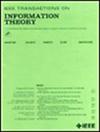Entanglement-Assisted Covert Communication via Qubit Depolarizing Channels
IF 2.2
3区 计算机科学
Q3 COMPUTER SCIENCE, INFORMATION SYSTEMS
引用次数: 0
Abstract
We consider entanglement-assisted communication over the qubit depolarizing channel under the security requirement of covert communication, where the transmission itself must be concealed from detection by an adversary. Previous work showed that通过质子去极化通道进行纠缠辅助隐蔽通信
在隐蔽通信的安全要求下,我们考虑量子比特去极化信道上的纠缠辅助通信,其中传输本身必须被对手检测到。先前的研究表明$O(\sqrt {n})$信息位可以在没有纠缠辅助的情况下可靠地、秘密地在n个信道中传输。然而,Gagatsos等人(2020)表明,对于连续变量波色子通道,纠缠辅助可以将这种缩放增加到$O(\sqrt {n}\log {n})$。在这里,我们提出了一个有限维并行,并表明$O(\sqrt {n}\log {n})$隐蔽比特可以在n次使用量子比特去极化信道中可靠地传输。编码方案采用“弱”纠缠态,使其振幅的平方尺度为$O\left ({{{\scriptstyle \text {}^{\scriptstyle 1}}\hspace {-0.224em}/\hspace {-0.112em}{\scriptstyle \sqrt {n}}}}\right)$。
本文章由计算机程序翻译,如有差异,请以英文原文为准。
求助全文
约1分钟内获得全文
求助全文
来源期刊

IEEE Transactions on Information Theory
工程技术-工程:电子与电气
CiteScore
5.70
自引率
20.00%
发文量
514
审稿时长
12 months
期刊介绍:
The IEEE Transactions on Information Theory is a journal that publishes theoretical and experimental papers concerned with the transmission, processing, and utilization of information. The boundaries of acceptable subject matter are intentionally not sharply delimited. Rather, it is hoped that as the focus of research activity changes, a flexible policy will permit this Transactions to follow suit. Current appropriate topics are best reflected by recent Tables of Contents; they are summarized in the titles of editorial areas that appear on the inside front cover.
 求助内容:
求助内容: 应助结果提醒方式:
应助结果提醒方式:


